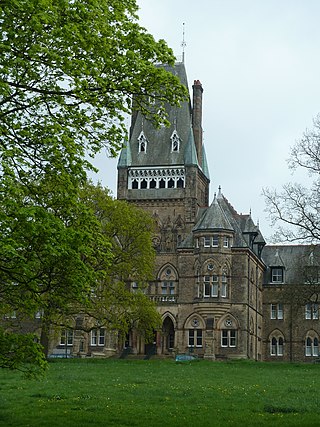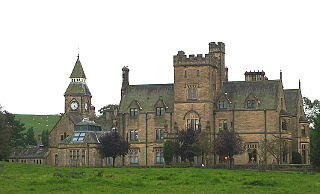
A bungalow is a small house or cottage that is single-storey, sometimes with a smaller upper storey set in the roof and windows that come out from the roof, and may be surrounded by wide verandas.

Pleasley is a village and civil parish with parts in both Derbyshire and Nottinghamshire. It lies between Chesterfield and Mansfield, 5 miles (8 km) south east of Bolsover, Derbyshire, England and 2.5 miles (4 km) north west of Mansfield, Nottinghamshire. The River Meden, which forms the county boundary in this area, runs through the village.

Beamish Museum is the first regional open-air museum, in England, located at Beamish, near the town of Stanley, in County Durham, England. Beamish pioneered the concept of a living museum. By displaying duplicates or replaceable items, it was also an early example of the now commonplace practice of museums allowing visitors to touch objects.

A model village is a mostly self-contained community, built from the late 18th century onwards by landowners and business magnates to house their workers. "Model" implies an ideal to which other developments could aspire. Although the villages are located close to the workplace, they are generally physically separated from them and often consist of relatively high-quality housing, with integrated community amenities and attractive physical environments.

Elsecar is a village in the Metropolitan Borough of Barnsley in South Yorkshire, England. It is near to Jump and Wentworth, it is also 2 miles (3.2 km) south of Hoyland, 6 miles (9.7 km) south of Barnsley and 8 miles (13 km) north-east of Sheffield. Elsecar falls within the Barnsley Metropolitan Borough Ward of Hoyland Milton.

A pit village, colliery village or mining village is a settlement built by colliery owners to house their workers. The villages were built on the coalfields of Great Britain during the Industrial Revolution where new coal mines were developed in isolated or unpopulated areas. Such settlements were developed by companies for the incoming workers.

Huntington is a civil parish and former mining village in Staffordshire, on the outskirts of Cannock Chase. It lies on the A34 road just north of Cannock and is surrounded by woodland. The village had an estimated population of 3,720 in 2004, increasing to 4,536 at the 2011 Census. The population in Huntington on the 2021 census was 4,715, a 3.94% increase from the decade before.

Creswell Model Village is an arts and crafts style model village in the village of Creswell, Derbyshire, England. The pit village was built in 1895 by the Bolsover Colliery Company to designs by architect Percy B. Houfton for the workers of Creswell Colliery on land leased from the Welbeck Estate. Influenced by garden village principles, it provided the workers with modern facilities; it had a tramway to deliver coal to the houses. Designed around a large oval village green with an access road through the centre, the houses are of varying styles. The Model as it is known, has been refurbished.

Creswell is a former mining village located in the Bolsover district of Derbyshire, England. At the 2011 Census population details were included in the civil parish of Elmton-with-Creswell. Today it is best known for Creswell Crags and its model village. In September 1950 Creswell Colliery was the scene of one of the worst post-nationalisation mining disasters. Elmton Common is an area of allotments for the township of Creswell.
Pentre Berw is a small village located on the island of Anglesey in north Wales. It lies about 2 miles (3.2 km) south of the county town of Llangefni, and next to Gaerwen.

Whaley Thorns is a former colliery village in the Bolsover district of Derbyshire, England, close to the Nottinghamshire border. Whaley Thorns lies just north of Nether Langwith and Langwith, 1.5 miles (2.4 km) south-east of Creswell, and west of Cuckney. It is in the civil parish of Langwith.

1–11 and 13 Bath Street consists of a row of six attached cottages and a separate town house on the east side of Bath Street, Chester, Cheshire, England. Both the row of cottages and the house are recorded in the National Heritage List for England as designated Grade II listed buildings.

Haigh Hall is a historic country house in Haigh, Wigan, Greater Manchester, England. Built between 1827 and 1840 for James Lindsay, 7th Earl of Balcarres, it replaced an ancient manor house and was a Lindsay family home until 1947, when it was sold to Wigan Corporation. The hall is recorded in the National Heritage List for England as a designated Grade II* listed building and is owned by Wigan Council.
Mosley Common Colliery was a coal mine originally owned by the Bridgewater Trustees operating on the Manchester Coalfield after 1866 in Mosley Common, Greater Manchester, then in the historic county of Lancashire, England. The colliery eventually had five shafts and became the largest colliery on the Lancashire Coalfield with access to around 270 million tons of coal under the Permian rocks to the south.

The Royal Albert Hospital was a hospital in Lancaster, Lancashire, England. It opened in 1870 as an institution for the care and education of children with learning problems. By 1909 there were 662 children in residence. Following new legislation in 1913, adults were also admitted. By the time of the introduction of the National Health Service in 1948 the hospital had 886 patients, and by the 1960s there were over 1,000 patients. Following legislation in the 1980s, the patients were relocated in the community, and the hospital closed in 1996. The building was acquired by Jamea Al Kauthar Islamic College to provide Islamic education for girls. The main part of the hospital is recorded in the National Heritage List for England as a designated Grade II* listed building, and its west lodge is listed at Grade II.

Sedgwick House is located to the west of the village of Sedgwick, Cumbria, England. It was built as a country house, was later used as a school, and then converted into apartments. The house is recorded in the National Heritage List for England as a designated Grade II listed building.

Rounton Grange was a country house in East Rounton, a village in North Yorkshire, in England.

Todenham is a village and civil parish in the Cotswold district of Gloucestershire, England. The village is significant for its Grade I listed 14th-century parish church.
Old Bolsover is a civil parish in the Bolsover District of Derbyshire, England. The parish contains 55 listed buildings that are recorded in the National Heritage List for England. Of these, one is listed at Grade I, the highest of the three grades, six are at Grade II*, the middle grade, and the others are at Grade II, the lowest grade. The parish contains the market town of Bolsover and the surrounding area, including the village of Shuttlewood. The older part of the town has been a market town since the medieval period, and the area of New Bolsover is a model village built between 1888 and 1893 for colliery workers. A row of six semi-detached houses was built for the managers, over 200 houses were built for the other workers in terraces forming three sides of a quadrangle, and community buildings were also erected. All these buildings are listed. The most prominent building in the parish is Bolsover Castle, a country house in the style of a castle, which is listed, together with associated structures, including five conduit houses. Most of the other listed buildings are houses, cottages, shops and associated structures, farmhouses and farm buildings. The rest include a church, a chapel, a former windmill and a nearby chimney, a war memorial, a school and a telephone kiosk.

Brereton House is a historic building in Goathland, a village in North Yorkshire, in England.


















